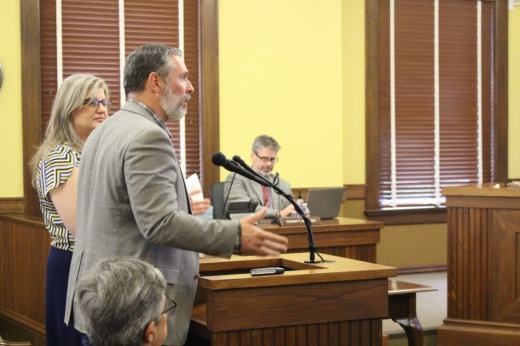On Feb. 28, executives of local nonprofits asked Fort Bend County Commissioners Court to reallocate $13 million in federal funds given to the county for a multiphase transitional housing program. If approved, the program could build multifamily duplexes and a centralized resource center as well as hire staff to help homeless individuals.
On Feb. 14, the court approved the transfer of $2 million from its Emergency Rental Assistance budget for this program. The nonprofits said they aim to utilize the rest of the requested funds to kickstart the program and use future Community Development Block Grant funding for the remainder.
The nonprofits await a decision as commissioners re-evaluate the use of these funds, which are allocated toward other community commitments, including broadband connectivity and infrastructure investments.
During the Feb. 28 meeting, Precinct 1 Commissioner Vincent Morales—whose jurisdiction includes Katy and Fulshear—said there was a need for the program but urged the court to work with the budget office to flesh out the remaining balance in the American Rescue Plan Act funding pot.
However, County Judge KP George said the county has a “once-in-a-lifetime chance” to address the issue of homelessness.
“These [groups] mentioned here, they are all waiting for our move,” he said. “They are saying, ‘OK, you’re lecturing about poverty, then put some money where your mouth is.’”
Fulshear Mayor Aaron Groff—who also serves as the executive director of Abigail’s Place, an organization that houses single mothers and their families—said this program is a proactive approach to continue supporting homeless families and individuals within the county.
“The need is there,” Groff said. “[At Abigail’s Place], we have a continuous waiting list. We have currently 900 families who are receiving rental assistance through the county program that ends [March 30].”
Proposed program
A homeless-needs inventory and gap analysis was drafted in late February by the county’s Community Development Director Carol Borrego and other local agencies. This report is part of an allocation plan due to the U.S. Department of Housing and Urban Development by March 31.
The report showed there were 14,120 households in Fort Bend County who earn less than 30% of the county’s area median income based on data from the county’s 2020 Consolidated Plan, making them vulnerable to homelessness.
It also found a shortage of rental housing within the county’s housing options for people at risk of homelessness. The analysis identified emergency shelters as first priority for homeless individuals and families, as the county’s two emergency shelters are exclusively for at-risk youth or women.
Aside from Abigail’s Place, eight other local organizations collaborated on the housing proposal for Fort Bend County, including Parks Youth Ranch based in Richmond, Hope Impacts in Katy, Attack Poverty, the George Foundation, Fort Bend Family Promise and Fort Bend Women’s Center.
Shannan Stavinoha, executive director for Parks Youth Ranch, said the nonprofit is the only emergency shelter for abused and neglected youth ages 7-17 in the county, and it assisted 177 youths in 2022.
Data from Lamar CISD and Katy ISD showed homelessness is an issue for the county’s youth as well. In the two districts combined, there have been 1,417 homeless students recorded in the 2022-23 school year.
Tracking adult homelessness is difficult, the nonprofits said. The county’s gap analysis reported the Coalition for the Homeless of Houston’s 2022 Point in Time Count that showed 38 sheltered and 43 unsheltered persons largely undercounts the number of homeless, as there are no shelters for single adults in the county.
“That is the big part that we want to communicate. It is not just an affordable housing apartment complex,” Stavinoha said. “This project includes case management, workforce development, education support—all of those things are so vitally important, and we need to make sure that we are getting to the root of each family’s challenges and their crises.”
In all, the program incorporates emergency shelter; transitional housing; supervised independent living for youth aging out of foster care; and permanent housing for individuals with major behavioral or health needs. The highlight for nonprofit executives is a centralized resource center they plan to build within the first two years of implementation.
It also would supply affordable rental housing structured as multifamily housing, where residents would not spend more than 30% of their pretax income on housing, as well as affordable homeownership—which would include homebuyer education and down payment assistance programs.
Precinct 4 Commissioner Dexter McCoy applauded the groups’ efforts to encompass homeownership into its programming but said he would not support removing federal funding from other initiatives—such as $4.3 million dedicated to a broadband connectivity project meant to bring high-speed internet to rural areas.
“We have been let down by the state of Texas before in giving necessary funds for infrastructure, and I want to make sure we have this to be able to really help those people who, on the ground today, need that help,” he said.
Current allocations
The three budgets the nonprofits are requesting federal funds from are the Home American Rescue Plan, American Rescue Plan Act and Emergency Rental Assistance. The county received these one-time allocations in 2020-21 to provide relief from COVID-19.
The transitional housing plan would require the county to reallocate $8 million from its ARPA budget as well as the $2 million from the ERA budget commissioners approved Feb. 14, Groff said.
Additionally, the nonprofits requested using $3 million from the Home American Rescue Plan budget, a portion of CDBG funding received from HUD in 2021.
Borrego, who manages CDBG and Home ARP funds, advised the court that HUD money should be the last dollars considered—as restrictions for their use will be stringent, she said.
Namely, the $3.32 million allocated to the county from the Home ARP grant can only be used with four specified activities to aid qualifying populations—such as the homeless and those at risk of homelessness, veterans, and those fleeing domestic violence.
Those activities are the production or preservation of affordable housing; tenant-based rental assistance; homeless prevention or housing counseling services; and the development of emergency shelter that provides private space for guests, such as motel rooms.
Precinct 3 Commissioner Andy Meyers said he would rather see the ARPA funds used to reverse the county’s employee health benefits debt. He also said he did not consider the reallocation to a transitional housing program a viable use of funds.
“Providing the services are not typical county services,” Meyers said. “These are services that are provided by the federal and state agencies, since they have additional revenue sources that the county does not have.”
After Stavinoha’s Feb. 28 presentation, George again implored the court to take action on this issue.
“We had $157 million from ARPA funding. We are talking about $8 million investing in the future of our children and the homeless,” George said. “If we have a hard time doing that, I don’t know what else to say.”
Although McCoy expressed his support of the program, he wanted to ensure the court was clear on the funds that were left in these pots to support other initiatives important to county residents.Groff, who said he is in a “unique position” to understand some of the commissioners’ hesitation to reallocate funding, wanted to ensure the requested funds were a bid to better utilize federal moneys and not county dollars.
“Let’s not send any money back [to the U.S. Treasurer] if those dollars are available,” Groff said. “Our ask is, if we can leverage those [federal] dollars to make a long-term impact in the county, then we can use this as a model for sustainable projects moving forward.”







